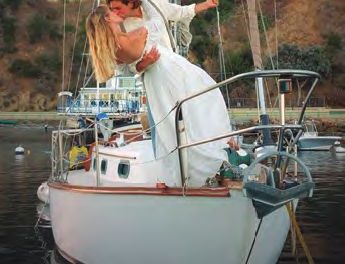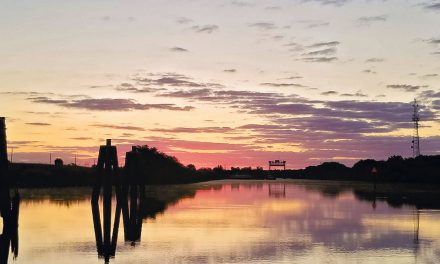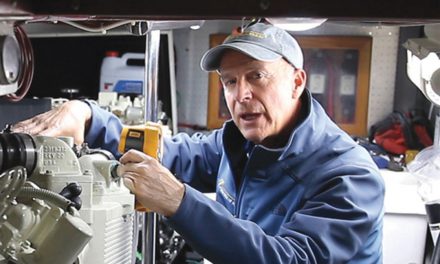Finding their perfect boat had less to do with love than with research, compromise, and patience.
Issue 136: Jan/Feb 2021
We’ve all heard the story: Man or woman sees boat, falls in love, opens wallet, lives in happy torment ever after, working to make true love perfect. Some of us live this story repeatedly throughout our lives; after all, those of us who love sailing really love sailboats.

Mark developed a sailing criteria spreadsheet that helped him compare various boats he and Dawne sailed and examined; the Catalina’s performance, assessed in part with this information, has not let him down.
But there’s a lot that’s potentially unhappy about this story, because we all know that love is blind. So, when the time came for my wife, Dawne, and I to find the perfect boat for us, we chose a path that depended less on Boat Cupid and more on careful planning, research, and above all, compromise.
Before we met, I’d spent my entire life on the water, from racing sailboats in college to commercial boating in Alaska. When we met, Dawne only knew the bow was the front end. I introduced her to sailing, but it wasn’t for her. Enter our first boating-related compromise: We bought a powerboat. Anything to get us out on the water was fine by me, and all the while, I hoped she’d come around to sailing.
And eventually, she did. Years later, when we were between powerboats, Dawne suggested we get a sailboat. I was overjoyed, but I knew it was especially important to make the right choice the first time. To accomplish that, we needed to take the time to define and research our perfect sailboat.
The first order of business was to determine together how we would use our new boat. My mind ran wild! I’ve been part of some pretty serious race crews around the area and do enjoy racing, so perhaps a lightweight, tall-rigged racer/cruiser was in our future? No. Dawne was not game for spending her sailing days as rail meat seeking victory. And rationally, I understood the wear and tear that racing imparts, and that the expense of maintaining a competitive boat was not in our budget. Besides, I could sate my need for speed crewing in races on OPBs (other people’s boats).
My focus turned to visions of standing on the bowsprit of a salty, double-ended cutter, watching the Washington coast disappear in a shroud of fog as we sailed out into the Pacific. But deep down, I knew that my bluewater dreams were pure fantasy, and that Dawne’s idea of losing sight of land is to close her eyes for a nap on deck. Living in the Pacific Northwest means that we have access to protected waters from Olympia, Washington, to Skagway, Alaska, and I knew that I could easily satisfy my wanderlust close to home.
Finding a mutual focus on how we would use our next boat was key in narrowing down design, rig, target displacement, and general cabin layout. But the devil would be in the details. To effectively dig into those details, we turned our vacations into weeklong sailboat charters. We used these times to identify features that were most important to each of us. While I feel as though I boarded each boat with a pretty good idea of what I liked and what I didn’t, Dawne needed several days aboard to define her list (and who was I to turn down a chance at going sailing for a week?).
On the first charter, we both found climbing down a ladder into the dinghy to be a little tricky. When our new-to-us dog, Capo, joined us on the second cruise, this got even more troublesome. Not only did a walk-through transom move way up on both our lists, it also prompted another decision about how our sailing lives would look: We’d spend about half our time at anchor (what I like) and half our time in a marina (what Dawne likes).
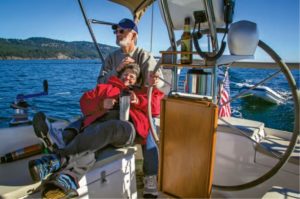
Days like this during one of Mark and Dawne’s charters helped them hone their idea of the perfect boat.
By the end of the third charter, we’d produced a comprehensive list of what mattered most to each of us. There was a gap between our respective definitions of the perfect boat, but meeting each other in that gap is called compromise, and it came easily—much more easily than it would have with a boat only one of us was excited about.
All the while, we resolved another important pre-shopping question: How much money could we spend on buying and owning a boat? Were the decision mine alone, I’d have contacted Bob Perry right away to start the design process for our new boat. But then, fiscal responsibility has never been my strength. It is Dawne’s. We set a firm upper limit and pretty much stuck to it. And rather than choosing a low-priced fixer-upper and trying to estimate the down-the-road costs, we focused on finding the most cruise-ready boat within our budget.
Over three years had passed since our decision to buy a sailboat, but it was time well spent. We were now in the home stretch, turning our attention to specific boat-purchase questions. How big should the boat be? What rig would be best? Hull material and design? How heavy should the hull be? What else did our chartering identify as important features?
Well, we knew we wanted to cruise comfortably with at least one other couple, so two staterooms were important. I’m tall, so headroom was important. Dawne wanted a head compartment that included a shower. These considerations pointed to a boat in the range of 32 to 38 feet. We decided to limit our search to sloops and cutters rather than split rigs like yawls or ketches.
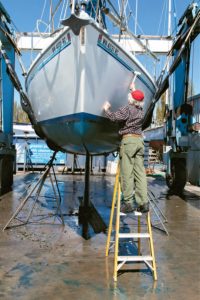
The surveyor’s dreaded hammer at work during the survey of Fiddler’s Green, the Catalina 320 Mark and Dawne would eventually buy.
About this time, I picked up Chuck Gustafson’s book, How to Buy the Best Sailboat. It’s packed with information about comparing the virtues of different construction materials, rigs, and hull shapes. But the most important takeaway for me was the chapter on performance criteria. I went so far as to create a spreadsheet so I could input numbers from every boat we considered, allowing us to compare boats side by side. Looking at ratios like displacement/length and ballast/displacement of boats we’d sailed helped us to anticipate performance and seakindliness of boats we were considering. Some might say this exercise was overkill, but we used these comparisons to narrow in on our ultimate pick, and our projections of her sailing qualities proved accurate.
Our final consideration before diving into the listings was defining our search area. We knew a couple who found their perfect 40-foot boat in Michigan, but then learned that decommissioning, trucking from Michigan to Washington, and commissioning cost two-and-a-half times more than they had been led to believe. We ruled out trucking to stay within our budget. Buying a boat in Southern California was an option, but that would require that we either pay more for a newer boat ready to make the trip north or tackle necessary projects while staying in a California port, adding more expense. We decided to focus our search locally and see what we could find.
It didn’t take long to come up with good candidates. One thing that proved invaluable at this point was a three-page “initial survey” checklist I made and carried with me aboard every boat we saw. It forced me to focus on problem areas before Boat Cupid could spear me with an arrow. Issues I spotted myself that removed a boat from consideration helped preclude us from paying for a professional survey for a boat we would end up not buying. My list included very specific items related to the hull, rig, deck, below deck, and systems. If the boat was on the hard, signs of a hard grounding or keel separation were red flags. Signs of major leaks below, especially if leading to rot, or significant engine issues would end our visit.
It didn’t take long for us to find the boat we ended up buying: a 1993 Catalina 320 named Fiddler’s Green. She was lying in Port Hadlock, Washington, with an asking price of $40,500. I read a somewhat dated but positive review of the Catalina 320 that Practical Sailor had published shortly after the new model was released.
The specs in this boat’s listing were obviously copied from another listing, and the photos showed a dirty boat with the photographer’s feet or belly in some of the shots. (Note to boat sellers: Please don’t include body parts in photos of your boat!) We almost passed her by.
But with low expectations, we made an appointment to see her. Sure, she was unkempt and even neglected, but I couldn’t find any evidence of issues big enough to turn us away. We struck a deal and enjoyed a fantastic sea trial in a steady 6 knots of breeze. We scheduled a haulout and survey. Our surveyor found a handful of minor issues but nothing that killed the deal.
Having owned Fiddler’s Green for a few years, I’m pleased to report that our purchase approach was a success. All told, she’s been a fun boat to own and sail, and I think the decisions and compromises we made up front are what led us to buying a boat that best meets all of our needs, the perfect boat for us.
Mark Cole learned to sail while in the Navy stationed in Japan in the mid-1970s. He and Dawne have been together more than 30 years, having lived aboard a 55-foot 1958 Chris- Craft at one point. During this time, he earned his USCG 100-ton master’s license and served as a bridge officer on commercial vessels, including working for a small cruise ship company in Southeast Alaska. He and Dawne now cruise the Salish Sea of Washington State and British Columbia.
Thank you to Sailrite Enterprises, Inc., for providing free access to back issues of Good Old Boat through intellectual property rights. Sailrite.com



